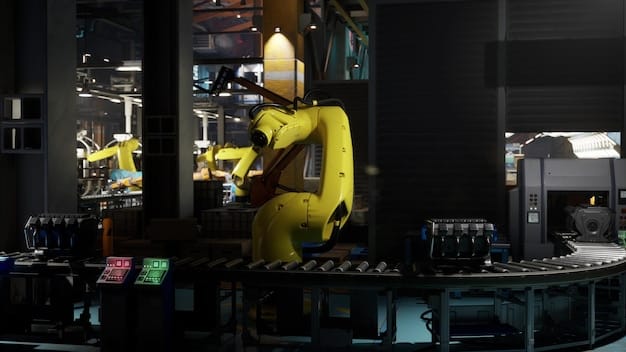Navigating US Labor Market Trends: Skills Gap and Workforce Shortages

US Labor Market Trends reveal a growing skills gap and workforce shortages, requiring strategic solutions for businesses to remain competitive and adapt to the evolving demands of the economy.
The Labor Market Trends: Navigating the Skills Gap and Workforce Shortages in the US are presenting unprecedented challenges to businesses across the nation. Understanding these trends is crucial for organizations looking to stay competitive and build a resilient workforce.
Understanding the Current State of the US Labor Market
The US labor market is currently facing a complex combination of factors. Decreasing participation rates, technological advancements, and shifting demographics are contributing to a significant skills gap and widespread workforce shortages.
Decreasing Labor Force Participation
One of the primary issues is the declining labor force participation rate. This trend is influenced by factors such as an aging population, early retirements, and individuals choosing not to re-enter the workforce after the pandemic.
- Aging Population: As more baby boomers retire, the number of available workers decreases.
- Early Retirements: The pandemic accelerated retirement plans for many individuals.
- Skills Mismatch: Some potential workers lack the skills required for available jobs.
These factors collectively reduce the overall pool of available workers, exacerbating shortages in various sectors.
The Growing Skills Gap in Key Industries
The skills gap refers to the mismatch between the skills employers require and the skills job seekers possess. This gap is particularly pronounced in industries undergoing rapid technological transformation.
Technology and Automation
Advancements in technology and automation are reshaping job roles, requiring workers to acquire new technical skills. Many individuals lack the necessary training to meet these demands.

- Digital Literacy: Basic computer skills are now essential across most industries.
- STEM Skills: Science, Technology, Engineering, and Mathematics (STEM) skills are in high demand.
- Data Analysis: The ability to interpret and analyze data is becoming increasingly important.
Addressing this skills gap requires a multi-faceted approach involving education, training, and employer-led initiatives.
Strategies for Businesses to Address Workforce Shortages
To combat workforce shortages, businesses need to adopt innovative strategies that attract, retain, and develop talent. This involves rethinking traditional hiring practices and investing in employee training.
Enhancing Recruitment and Retention
Businesses can improve their recruitment efforts by expanding their search beyond traditional channels and offering competitive compensation and benefits packages.
- Competitive Compensation: Offering salaries and benefits that are in line with or above market standards.
- Flexible Work Arrangements: Providing options such as remote work, flexible hours, and compressed workweeks.
- Career Development Opportunities: Offering training programs and opportunities for advancement.
Additionally, fostering a positive work culture and prioritizing employee well-being can significantly improve retention rates.
The Role of Education and Training Programs
Education and training programs play a crucial role in bridging the skills gap and preparing workers for the jobs of the future. Collaboration between educational institutions and employers is essential.
Partnerships with Educational Institutions
Businesses can partner with colleges, universities, and vocational schools to develop curricula that align with industry needs. This ensures that graduates possess the skills employers are seeking.

- Internship Programs: Providing students with real-world work experience.
- Apprenticeships: Combining on-the-job training with classroom instruction.
- Skills-Based Training: Offering short-term training programs focused on specific skills.
These partnerships can help create a pipeline of skilled workers who are ready to contribute to the economy.
Government Policies and Initiatives Supporting Workforce Development
Government policies and initiatives are also critical in addressing labor market challenges. These efforts include funding for training programs, tax incentives for businesses, and policies that support workforce participation.
Funding and Incentives
Government funding can support training programs targeted at high-demand industries. Tax incentives can encourage businesses to invest in employee development and training.
Policies that promote affordable childcare, paid family leave, and access to healthcare can help increase workforce participation rates, especially among women and caregivers.
By investing in workforce development, governments can help ensure a strong and competitive labor market.
Future Trends and Predictions for the US Labor Market
Looking ahead, several key trends are expected to shape the US labor market. These include the continued rise of automation, the increasing importance of soft skills, and the growing demand for remote work options.
Automation and AI
Automation and artificial intelligence (AI) will continue to transform job roles, requiring workers to adapt and acquire new skills to work alongside these technologies. Lifelong learning will be essential.
Moreover, soft skills such as communication, critical thinking, and problem-solving will become increasingly valuable. These skills are difficult to automate and are essential for collaboration and innovation.
The increasing adoption of remote work will enable businesses to tap into a wider talent pool and offer employees greater flexibility.
| Key Point | Brief Description |
|---|---|
| 📉 Declining Participation | Aging population and early retirements reduce available workers. |
| 💻 Tech Skills Gap | Mismatch between required tech skills and available talent. |
| 🤝 Partnerships | Education and employer collaboration for relevant training. |
| 🤖 Automation Impact | Automation transforming roles, requiring continuous skill updates. |
Frequently Asked Questions (FAQ)
▼
The skills gap refers to the difference between the skills employers need and the skills that the available workforce possesses. It’s a mismatch that can hinder productivity and economic growth.
▼
Workforce participation is declining due to factors like an aging population, early retirements, and some people opting out of the workforce. These factors reduce the pool of available workers.
▼
Businesses can attract talent by offering competitive compensation, flexible work arrangements, and opportunities for career development. A positive work culture is also essential for attracting and retaining employees.
▼
Education and training programs are crucial for bridging the skills gap. Partnerships between educational institutions and employers ensure that curricula match industry needs, preparing students effectively.
▼
Automation will continue to transform job roles, requiring workers to adapt and learn new skills. Soft skills and the ability to work with AI will become increasingly important for future success.
Conclusion
Navigating the complexities of the US labor market requires a comprehensive approach that includes investing in education, promoting workforce participation, and adapting to technological advancements. By addressing the skills gap and workforce shortages, businesses and policymakers can ensure a strong and competitive economy.





